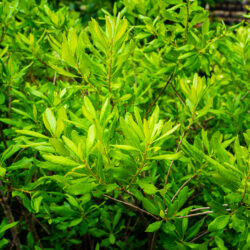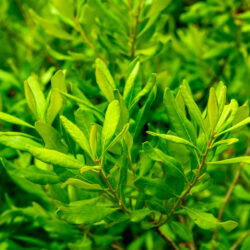Etymology
Morella is likely most likely derived from morus, the Latin name for the mulberry tree; caroliniensis is Latin for a species having a range including North and South Carolina in the United States.
Native Habitat
Dunes, forest edges, meadows and fields, ridges and ledges, roadsides and pine barrens.
Garden Uses
Bayberry's persistent winter fruit makes it an excellent addition to any landscape. Its value is further enhanced by its versatility, durability and low maintenance. It is resistant to a wide range of challenges, including salt, drought and pests, and can grow well in poor, sandy or gravelly soils. Bayberry is a great choice for woodland gardens, privacy screens, garden shrub borders, shoreline restoration, roadway plantings and parking lots. It can be pruned to various heights to meet your garden needs, and can be incorporated into a mixed planting or used to create a beautiful screen or hedge. To encourage a dense planting, simply allow the rhizomatous stems to form colonies.
Overview
Bayberry is a woody understory shrub that is deciduous throughout its range, but may remain semi-evergreen during mild winters. This is a highly versatile plant, growing in both dry and wet conditions and it is great for wildlife gardens, providing food and cover for birds and serving as a host plant for butterflies. Bayberry can thrive in a variety of light conditions, from dappled sunlight to full sun and partial shade. It tends to grow with a spreading or suckering habit, forming a dense and rounded shape. In the fall and winter, waxy round bluish-white fruits mature on female plants in clusters on short stalks.
Leaves and Stems
Foliage is green, waxy, leathery, simple and alternate with toothed margins. Leaves are 1" to 3" long and 1/4" to 1" wide with resinous glands on the underside. Foliage is fragrant when crushed. Stem bark is thin, smooth, and gray-brown.
Flowers
Small male and female slim cylindrical flowers appear in spring.
Fruit/Seed
Female plants produce waxy fruits in shades of blue, gray/silver, and white. Fruits occur along the stem, interspersed among the leaves.
Wildlife Associates
Winter fruit and late season leaf retention make bayberry a valuable source of food and shelter for wildlife. Its fruits are eaten by birds in the fall and winter.
During the warmer months, bayberry is host to 70 caterpillar species including laurel sphinx, apple sphinx, promethea silkmoth, luna moth, spiny oak- slug moth, red-humped caterpillar, imperial moth and polyphemus moth.
Propagation
Bayberry shrubs may be started vegetatively or from seed. Vegetative propagation is achieved by cuttings or division of suckering plants. Seed is hand harvested in the fall from September to October. When the seed is ready to be planted, remove the waxy coating from the fruit with physical agitation. Seeds require a cold period to germinate - a minimum of 90 days below 40°F in moist soil, sand or vermiculite. Sow outdoors in pots, on the soil surface and leave uncovered, November through mid-February. Because this species can be challenging to grow from seed, it may be suitable for more experienced seed-sowers.
Ethnobotanical Uses
The fragrant leaves of Northern bayberry can be used in cooking like traditional bay leaves to flavor dishes. The waxy coating on the fruits has been used in candle making since colonial times when early American settlers produced highly valuable scented candles that did not sputter or smoke. The candles were labor intensive with each 2 ounce candle requiring 5-10 thousand fruits. The blue-green water produced after simmering the wax off the fruit was used to dye homespun cloth. Bayberry bark was used as a paste or powder to improve mouth infections. The Mi'kmaq used leaf snuff to treat headaches, tea from the leaves as a stimulant, and root bark as a poultice to reduce inflammation.
Garden Location
Entry Garden, Library Garden, Patio Garden, Performance Hall Garden, Residential Garden (see garden map)
Sources
North Carolina Extension Gardener Plant Toolbox
Plant Profile by Rachel Emus


